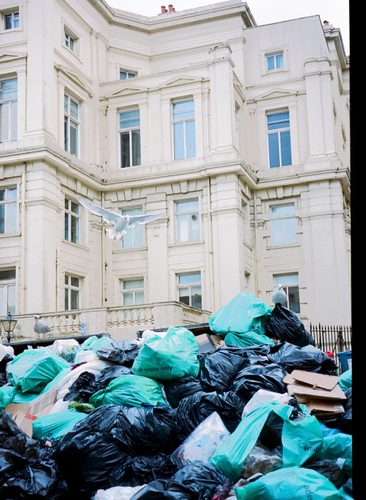

DEFINITION
Andréia Galvão
Climate justice activist
Today’s aggressive capitalist system is driven at its core by the maximisation of profit, regardless of social and ecological costs. This model is incompatible with a just and sustainable future. Moving away from Modernist development and the illusion of infinite economic growth is essential in the pursuit of an economy that prioritises responses to social needs, wellbeing and environmental equilibrium.
A new developmental paradigm means putting an end to the egregious waste of resources under capitalism, which is driven by large-scale production of useless and harmful products. It means questioning the systemic exploitation of resources, communities and territories in the Global South.
The logic of infinite development has been taught to us as inevitable. The climate justice movement aims to show the absurdity of the extractivist model and open an urgent world of possibilities for solving the most pressing challenge modern civilisations have faced.

Photography By Pamela EA
RESEARCH
Research and Text by Sorah Park
Fact-checked by Hailey Basiouny
In response to the alarming climate crisis, countries are tasked with the challenge of implementing sustainable development. A glance into the past demonstrates how economic development has required extraction and climate degradation. This poses the question: Is sustainable development an oxymoron? “Developed” countries have experienced rapid industrialization like the US, UK, and many western European nations, whereas “developing” countries have emerging economies and are typically located in the Global South. The Organization for Economic Cooperation and Development (OECD) is an intergovernmental organization with 38 member countries, predominantly high-income, “developed” nations. The OECD works with “developing” countries to create policies that improve well-being, productivity, and to close the global economic gap. However, these categories fail to capture the violent histories of overexploitation that have led to the classification of nation-states into these two broad groups, and inaccurately paint the Global North as the ideal world since socioeconomic inequalities exist within “developed” countries as well.
To tackle socioeconomic inequalities while combating the climate crisis, the United Nations developed 17 Sustainable Development Goals (SDGs) in 2015 as part of its 2030 Agenda for Sustainable Development—but are we on track to achieve these ambitious goals? Global greenhouse gas (GHG) emissions need to be reduced 43% by 2030 to prevent climate catastrophe. However, the current trajectory of GHG emissions is predicting a 14% increase by 2030. Is the aim of the SDGs to sustain the development patterns that have brought significant wealth to “developed” countries, or is it to recognize the environmental and social damages in the name of civilization and implement policies to prevent further destruction? Nemonte Nenquimo, first female leader of the Waorani tribe in the Amazon, called out this hypocrisy in her open letter to global leaders, “When you say that you are urgently looking for climate solutions, yet continue to build a world economy based on extraction and pollution, we know you are lying because we are the closest to the land, and the first to hear her cries”.
While a global UN guideline to achieve equity and sustainability by the next decade is a commendable deed, shortcomings exist that require urgent solutions to mitigate the most disastrous effects of climate change. Vulnerable communities in “developing” countries are getting hit the hardest even though they are the least responsible. “Developed” countries have historically emitted the most carbon into the atmosphere. While China currently has the highest GHG emissions of any country in the world, the U.S. leads the charge in historical emissions, having burned more fossil fuels since 1850 than all the 27 countries that make up the European Union combined. In 2010, the wealthiest economies pledged to provide $100 billion each year to poorer nations by 2020 to mitigate climate risks, but have fallen short on their promise.
The financial benefits of climate mitigation are impressive, since cooler temperatures enhance productivity, reduce pollution and bring health advantages. Researchers estimate that limiting warming to 1.5°C could save more than 20 trillion dollars around the world by 2100. Furthermore, the International Energy Agency estimates that worldwide annual clean energy investment will need to triple by 2030 to around $4 trillion to achieve a net-zero carbon economy and avert climate disasters. Historically, “developed” countries have prioritized economic development and have slowly been embracing a greener transition. Most recently, the U.S. passed its largest climate bill to tackle global warming and invest in building renewable energy infrastructure. While this bill is not set to meet the 50% reduction of emissions by 2030 compared to 2005 levels, it is a historic win for U.S. climate action since the U.S. bears the biggest historical responsibility for human-induced climate change caused by carbon emissions (Global Carbon Project, 2021). This is a first step towards repairing environmental damages beyond U.S. borders and a necessary example of reparation initiatives by the most “developed” nations.
Nemonte Nenquimo, “This Is My Message to the Western World – Your Civilisation Is Killing Life on Earth,” The Guardian (Guardian News and Media, October 12, 2020), https://www.theguardian.com/commentisfree/2020/oct/12/western-worldyour-civilisation-killing-life-on-earth-indigenous-amazon-planet.
Lauren Sommer, Connie Hanzhang Jin, and Rina Torchinsky, “These 4 Charts Explain Why the Stakes Are so High at the U.N. Climate Summit,” NPR (NPR, October 29, 2021), https://www.npr.org/2021/10/29/1045344199/cop26-glasgow-climate-summit.
Jocelyn Timperley, “The Broken $100-Billion Promise of Climate Finance - and How to Fix It,” Nature News (Nature Publishing Group, October 20, 2021), https://www.nature.com/articles/d41586-021-02846-3.
Mark Lynas, Benjamin Z Houlton, and Simon Perry, “Greater than 99% Consensus on Human Caused Climate Change in the Peer-Reviewed Scientific Literature,” Environmental Research Letters 16, no. 11 (October 19, 2021): 114005,https://doi.org/10.1088/1748-9326/ac2966.
IEA, “Net Zero by 2050”, IEA, Paris, (IEA, 2021), https://www.iea.org/reports/net-zero-by-2050.
Lisa Friedman and Brad Plumer, “Surprise Deal Would Be Most Ambitious Climate Action Undertaken by U.S.,” The New York Times (The New York Times, July 28, 2022), https://www.nytimes.com/2022/07/28/climate/climate-change-deal-manchin.html?referringSource=articleShare.
RESOURCES FOR FURTHER LEARNING
We use cookies to analyze site usage and enhance navigation. By accepting, you agree to our use of cookies. Accept
Subscribe to our newsletter and be the first to get news on climate literacy!

By submitting I confirm that I have read Climate Words’ privacy policy and agree that Climate Words may send me announcements to the email address entered above and that my data will be processed for this purpose in accordance with Climate Words’ privacy policy.